Tropism and infectivity of influenza virus, including highly pathogenic avian H5N1 virus, in ferret tracheal differentiated primary epithelial cell cultures
- PMID: 23255802
- PMCID: PMC3571379
- DOI: 10.1128/JVI.02885-12
Tropism and infectivity of influenza virus, including highly pathogenic avian H5N1 virus, in ferret tracheal differentiated primary epithelial cell cultures
Abstract
Tropism and adaptation of influenza viruses to new hosts is partly dependent on the distribution of the sialic acid (SA) receptors to which the viral hemagglutinin (HA) binds. Ferrets have been established as a valuable in vivo model of influenza virus pathogenesis and transmission because of similarities to humans in the distribution of HA receptors and in clinical signs of infection. In this study, we developed a ferret tracheal differentiated primary epithelial cell culture model that consisted of a layered epithelium structure with ciliated and nonciliated cells on its apical surface. We found that human-like (α2,6-linked) receptors predominated on ciliated cells, whereas avian-like (α2,3-linked) receptors, which were less abundant, were presented on nonciliated cells. When we compared the tropism and infectivity of three human (H1 and H3) and two avian (H1 and H5) influenza viruses, we observed that the human influenza viruses primarily infected ciliated cells and replicated efficiently, whereas a highly pathogenic avian H5N1 virus (A/Vietnam/1203/2004) replicated efficiently within nonciliated cells despite a low initial infection rate. Furthermore, compared to other influenza viruses tested, VN/1203 virus replicated more efficiently in cells isolated from the lower trachea and at a higher temperature (37°C) compared to a lower temperature (33°C). VN/1203 virus infection also induced higher levels of immune mediator genes and cell death, and virus was recovered from the basolateral side of the cell monolayer. This ferret tracheal differentiated primary epithelial cell culture system provides a valuable in vitro model for studying cellular tropism, infectivity, and the pathogenesis of influenza viruses.
Figures
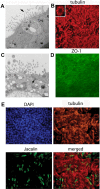

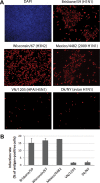
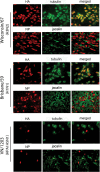
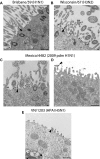

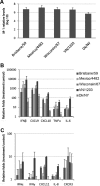
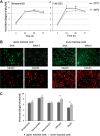
Similar articles
-
Tropism and Infectivity of a Seasonal A(H1N1) and a Highly Pathogenic Avian A(H5N1) Influenza Virus in Primary Differentiated Ferret Nasal Epithelial Cell Cultures.J Virol. 2019 May 1;93(10):e00080-19. doi: 10.1128/JVI.00080-19. Print 2019 May 15. J Virol. 2019. PMID: 30814288 Free PMC article.
-
Enhanced Human-Type Receptor Binding by Ferret-Transmissible H5N1 with a K193T Mutation.J Virol. 2018 Apr 27;92(10):e02016-17. doi: 10.1128/JVI.02016-17. Print 2018 May 15. J Virol. 2018. PMID: 29491160 Free PMC article.
-
Experimental adaptation of an influenza H5 HA confers respiratory droplet transmission to a reassortant H5 HA/H1N1 virus in ferrets.Nature. 2012 May 2;486(7403):420-8. doi: 10.1038/nature10831. Nature. 2012. PMID: 22722205 Free PMC article.
-
Role of receptor binding specificity in influenza A virus transmission and pathogenesis.EMBO J. 2014 Apr 16;33(8):823-41. doi: 10.1002/embj.201387442. Epub 2014 Mar 25. EMBO J. 2014. PMID: 24668228 Free PMC article. Review.
-
Influenza B Virus Receptor Specificity: Closing the Gap between Binding and Tropism.Viruses. 2024 Aug 24;16(9):1356. doi: 10.3390/v16091356. Viruses. 2024. PMID: 39339833 Free PMC article. Review.
Cited by
-
Inter-Species Host Gene Expression Differences in Response to Human and Avian Influenza A Virus Strains.Int J Mol Sci. 2017 Nov 1;18(11):2295. doi: 10.3390/ijms18112295. Int J Mol Sci. 2017. PMID: 29104227 Free PMC article.
-
Effect of receptor binding specificity on the immunogenicity and protective efficacy of influenza virus A H1 vaccines.Virology. 2014 Sep;464-465:156-165. doi: 10.1016/j.virol.2014.07.004. Epub 2014 Jul 30. Virology. 2014. PMID: 25078114 Free PMC article.
-
A Guide for the Use of the Ferret Model for Influenza Virus Infection.Am J Pathol. 2020 Jan;190(1):11-24. doi: 10.1016/j.ajpath.2019.09.017. Epub 2019 Oct 23. Am J Pathol. 2020. PMID: 31654637 Free PMC article. Review.
-
Interferon Lambda Upregulates IDO1 Expression in Respiratory Epithelial Cells After Influenza Virus Infection.J Interferon Cytokine Res. 2015 Jul;35(7):554-62. doi: 10.1089/jir.2014.0052. Epub 2015 Mar 10. J Interferon Cytokine Res. 2015. PMID: 25756191 Free PMC article.
-
Clinical profiles associated with influenza disease in the ferret model.PLoS One. 2013;8(3):e58337. doi: 10.1371/journal.pone.0058337. Epub 2013 Mar 5. PLoS One. 2013. PMID: 23472182 Free PMC article.
References
-
- Monto AS, Gravenstein S, Elliott M, Colopy M, Schweinle J. 2000. Clinical signs and symptoms predicting influenza infection. Arch. Intern. Med. 160:3243–3247 - PubMed
-
- Shinya K, Ebina M, Yamada S, Ono M, Kasai N, Kawaoka Y. 2006. Avian flu: influenza virus receptors in the human airway. Nature 440:435–436 - PubMed
-
- Abdel-Ghafar AN, Chotpitayasunondh T, Gao Z, Hayden FG, Nguyen DH, de Jong MD, Naghdaliyev A, Peiris JS, Shindo N, Soeroso S, Uyeki TM. 2008. Update on avian influenza A (H5N1) virus infection in humans. N. Engl. J. Med. 358:261–273 - PubMed
-
- de Jong MD, Simmons CP, Thanh TT, Hien VM, Smith GJ, Chau TN, Hoang DM, Chau NV, Khanh TH, Dong VC, Qui PT, Cam BV, do Q Ha, Guan Y, Peiris JS, Chinh NT, Hien TT, Farrar J. 2006. Fatal outcome of human influenza A (H5N1) is associated with high viral load and hypercytokinemia. Nat. Med. 12:1203–1207 - PMC - PubMed
-
- Baum LG, Paulson JC. 1990. Sialyloligosaccharides of the respiratory epithelium in the selection of human influenza virus receptor specificity. Acta Histochem. Suppl. 40:35–38 - PubMed
MeSH terms
Substances
LinkOut - more resources
Full Text Sources

